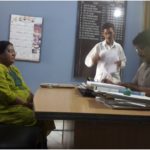The Asia Foundation (TAF) – Trans Boundary Disaster Management Training in collaboration with the Centre for Social Research (CSR) had conducted trainings in Nepal in addition to the completion of similar trainings in Bihar. The training at Saptari began from the 17th – 19th June 17, and the second such meeting was held in Sunsari, Nepal from the 21st – 23rd June 2017 with the help of the local partner Samudayik Sarathi. These trainings are conducted to improve the lives of communities, especially of vulnerable groups, especially women who are affected by yearly floods by enhancing women’s participation in local governance and decision making process, and reduce disaster risks and potential losses from natural hazards. All of these factors have been kept in mind bearing factors of stringent gender roles and overarching patriarchal values that are existent which make these women who are local leaders associated with political organisations further incapacitated. The training was attended by these women leaders from the districts of Saptari and Sunsari.


Objective
The training is a step towards bringing the public women representatives from both the communities under one roof and empathizes on the issues faced by them and support each other in the times of disaster. Community based flood risk management would give an opportunity to share, discuss and understand the management process and also make both the communities aware about the benefits of integrated approach to flood management. The objectives of the training are as follows –
1. To understand the role of gender and its importance during disaster management process.
2. To take initiative at the time of disaster and get equipped with disaster management strategies with a more collaborative and participatory approach at community level.
3. To form disaster management committee and take decisions in account of pregnant women, children and elderly.
Observation and analysis
While the trainings were in progress a few points of observation were made, some of which are as follows –
– The women leaders who participated in the trainings were found to be receptive, vocal and fast learners.
– Gender issues and discrimination are existent in terms of unequal distribution of at home between a male and female member within the family, unequal wages for women who work in laborious jobs, expectancy of traditional gender roles, decision making at home, and freedom of movement.
– In terms of basic understanding of sex and gender, there was a clear confusion between the act (copulation) of giving birth and the process (pregnancy) of giving birth.
– Floods in Nepal are dangerous not only on the Kosi River but also in the other adjoining rivers, where flash floods occur and the destruction is much more.
– The participants are aware of the concept of disaster, different kind of it; especially earthquake after the 2014 earthquake in the country. Floods however, are treated as a norm of nature.


Suggestions
– There needs to be a process of follow-ups after the trainings and hand-holdings to assess the how much of the information has been dispersed
– A plan of action for after the hand-holdings for larger involvement of the community on disaster
– Project can also incorporate the idea of advocacy beyond outreach
Transboundary Disaster Management Training in Nepal
Conclusion
The issues addressed during the training were to bring these local women to talk and discuss issues of climate change, disaster and its impact on the weak and vulnerable sections of society as well as the special needs of pregnant women who get neglected. Also, that these sections suffer more during natural disasters. Therefore, the importance has been placed on women’s leadership as necessary to achieve social change and progress. This belief of support and capacity-building of these women, that they will become strong and effective leaders in flood and disaster management and will support their communities in better adaption towards climate change was further reinforced by the proactive performance, participation and response in the two districts of Nepal




